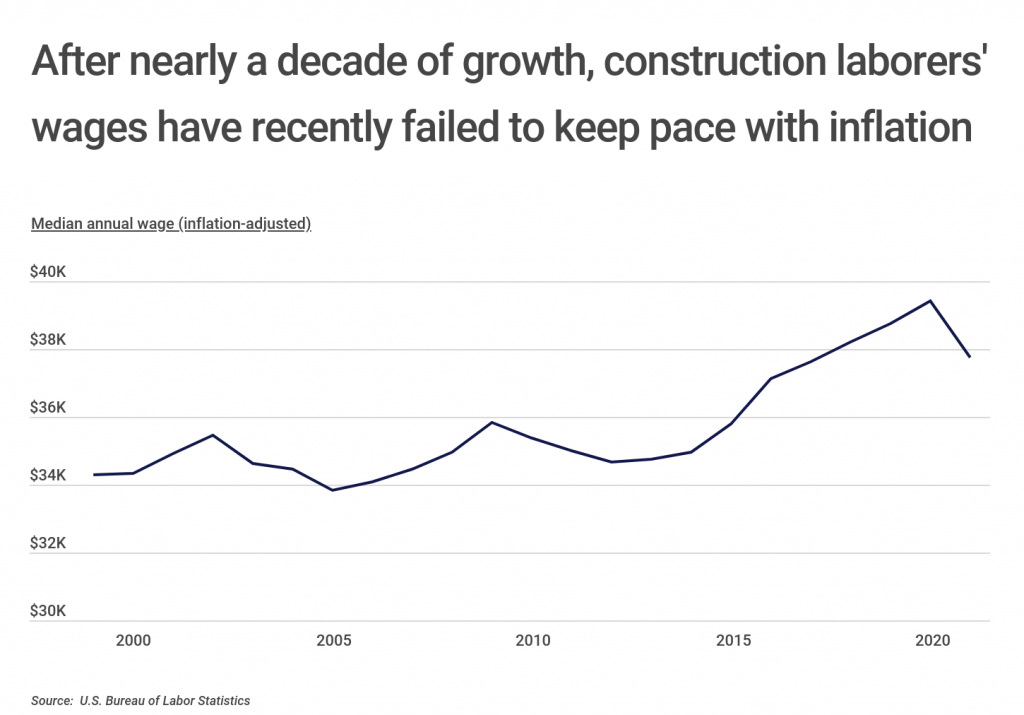
Photo Credit: Friends Stock / Shutterstock
With inflation remaining high, interest rates rising quickly, and the prospect of a recession looming, the construction industry in the U.S. is beginning to see signs of contraction after two years of rapid growth.
Since reaching a peak seasonally-adjusted annual rate of $1.8 trillion in June, construction spending in the U.S. has begun to fall in recent months. The downturn comes amid historically high levels of inflation and aggressive interest rate hikes from the U.S. Federal Reserve that have sent mortgage rates to heights not seen in twenty years. These conditions have made it more expensive to buy and build real estate, leading to lower demand for construction.

The recent downtick represents a reversal of the boom in spending that had taken place over the previous two years. Skyrocketing home prices and rents since the COVID-19 pandemic highlighted America’s underbuilt housing supply and led to increased spending on residential construction in particular. Since the beginning of 2020, inflation-adjusted residential construction spending has risen by more than 33% and surpassed spending on nonresidential construction for the first time since 2006. And despite a decline in nonresidential construction spending since 2020, total spending reached its highest levels in two decades earlier this year before declining in recent months.
High demand for construction in turn raised demand for construction labor. The industry has experienced shortages of workers for much of the last decade since the Great Recession. But between demand for construction and a tight labor market overall, the need for construction workers has become even more acute. Research from earlier in 2022 from Associated Builders and Contractors, a construction industry association, estimated a shortage of 650,000 construction workers this year.
One category of workers that has been in demand for the industry is construction laborers, who perform some of the most demanding physical labor on construction sites. Construction laborers totaled nearly 1 million workers in 2021, but they are also by far the lowest-paid profession in the construction industry with median annual wages of $37,770. The combination of difficult working conditions and low wages have made construction laborer roles challenging to fill, especially in a tight labor market.

Many construction employers have responded to this need with wage increases to recruit and retain workers. From 2012 to 2020, median inflation-adjusted wages grew from a post-recession low of $34,675 to $39,416 in 2021 dollars. But the onset of high inflation in 2021 has added another challenge to the market, as real wages for the typical construction laborer have now dropped to $37,770. A continuation of this trend could make it more difficult for the industry to find an adequate supply of laborers.

Some markets have done a better job than others of boosting wages to compete for workers and keep pace with inflation. In 21 states, inflation-adjusted wage growth was negative from immediately before the pandemic in 2019 to 2021. This includes three states—Rhode Island, Connecticut, and Alaska—where construction laborers’ wages declined by more than 10% in inflation-adjusted terms. In contrast, six states had inflation-adjusted wage increases for construction laborers of greater than 10% from 2019 to 2021, led by Indiana with a 14.6% increase. And at the metro level, Indiana and several other leading states like New York, Pennsylvania, and North Carolina have cities represented on the list for highest wage increases for construction laborers.
The data used in this analysis is from the U.S. Bureau of Labor Statistics and the U.S. Bureau of Economic Analysis. To determine the locations with the largest wage increases for construction laborers, researchers at Construction Coverage calculated the percentage change in annual wages from 2019 to 2021 after adjusting for local levels of inflation. In the event of a tie, the location with the greater unadjusted percentage change in annual wage was ranked higher.
Here are the U.S. metropolitan areas with the largest wage increases for construction laborers.

Large U.S. Metros With the Biggest Wage Increases for Construction Laborers

Photo Credit: Travellaggio / Shutterstock
15. Boston-Cambridge-Newton, MA-NH
- Percentage change in annual wage (inflation-adjusted): +6.9%
- Percentage change in annual wage (actual): +13.1%
- 2021 median annual wage (actual): $59,080
- 2019 median annual wage (actual): $52,240
- Total construction laborers: 13,760

Photo Credit: ESB Professional / Shutterstock
14. Atlanta-Sandy Springs-Alpharetta, GA
- Percentage change in annual wage (inflation-adjusted): +7.7%
- Percentage change in annual wage (actual): +13.1%
- 2021 median annual wage (actual): $36,590
- 2019 median annual wage (actual): $32,360
- Total construction laborers: 13,110

Photo Credit: dorinser / Shutterstock
13. Miami-Fort Lauderdale-Pompano Beach, FL
- Percentage change in annual wage (inflation-adjusted): +7.7%
- Percentage change in annual wage (actual): +14.3%
- 2021 median annual wage (actual): $37,110
- 2019 median annual wage (actual): $32,460
- Total construction laborers: 14,360

Photo Credit: Sean Pavone / Shutterstock
12. Detroit-Warren-Dearborn, MI
- Percentage change in annual wage (inflation-adjusted): +7.8%
- Percentage change in annual wage (actual): +12.7%
- 2021 median annual wage (actual): $46,210
- 2019 median annual wage (actual): $40,990
- Total construction laborers: 10,880

Photo Credit: Sean Pavone / Shutterstock
11. Tulsa, OK
- Percentage change in annual wage (inflation-adjusted): +7.8%
- Percentage change in annual wage (actual): +14.5%
- 2021 median annual wage (actual): $36,690
- 2019 median annual wage (actual): $32,030
- Total construction laborers: 2,650

Photo Credit: Sean Pavone / Shutterstock
10. Tampa-St. Petersburg-Clearwater, FL
- Percentage change in annual wage (inflation-adjusted): +8.6%
- Percentage change in annual wage (actual): +17.8%
- 2021 median annual wage (actual): $36,410
- 2019 median annual wage (actual): $30,920
- Total construction laborers: 10,200

Photo Credit: AevanStock / Shutterstock
9. Pittsburgh, PA
- Percentage change in annual wage (inflation-adjusted): +8.7%
- Percentage change in annual wage (actual): +14.6%
- 2021 median annual wage (actual): $47,050
- 2019 median annual wage (actual): $41,040
- Total construction laborers: 9,890

Photo Credit: Jacob Boomsma / Shutterstock
8. Tucson, AZ
- Percentage change in annual wage (inflation-adjusted): +9.4%
- Percentage change in annual wage (actual): +12.3%
- 2021 median annual wage (actual): $36,360
- 2019 median annual wage (actual): $32,370
- Total construction laborers: 2,370

Photo Credit: Sean Pavone / Shutterstock
7. Charlotte-Concord-Gastonia, NC-SC
- Percentage change in annual wage (inflation-adjusted): +10.0%
- Percentage change in annual wage (actual): +15.3%
- 2021 median annual wage (actual): $36,690
- 2019 median annual wage (actual): $31,820
- Total construction laborers: 8,400

Photo Credit: CHARLES MORRA / Shutterstock
6. Jacksonville, FL
- Percentage change in annual wage (inflation-adjusted): +10.2%
- Percentage change in annual wage (actual): +16.0%
- 2021 median annual wage (actual): $36,010
- 2019 median annual wage (actual): $31,050
- Total construction laborers: 5,450

Photo Credit: Sean Pavone / Shutterstock
5. New York-Newark-Jersey City, NY-NJ-PA
- Percentage change in annual wage (inflation-adjusted): +10.7%
- Percentage change in annual wage (actual): +17.2%
- 2021 median annual wage (actual): $59,250
- 2019 median annual wage (actual): $50,540
- Total construction laborers: 46,830

Photo Credit: Sean Pavone / Shutterstock
4. Memphis, TN-MS-AR
- Percentage change in annual wage (inflation-adjusted): +10.9%
- Percentage change in annual wage (actual): +16.9%
- 2021 median annual wage (actual): $36,570
- 2019 median annual wage (actual): $31,270
- Total construction laborers: 3,600

Photo Credit: Rudy Balasko / Shutterstock
3. Cincinnati, OH-KY-IN
- Percentage change in annual wage (inflation-adjusted): +12.0%
- Percentage change in annual wage (actual): +15.9%
- 2021 median annual wage (actual): $46,530
- 2019 median annual wage (actual): $40,130
- Total construction laborers: 6,330

Photo Credit: Richard Cavalleri / Shutterstock
2. Buffalo-Cheektowaga, NY
- Percentage change in annual wage (inflation-adjusted): +17.1%
- Percentage change in annual wage (actual): +23.7%
- 2021 median annual wage (actual): $45,850
- 2019 median annual wage (actual): $37,080
- Total construction laborers: 2,830

Photo Credit: Sean Pavone / Shutterstock
1. Indianapolis-Carmel-Anderson, IN
- Percentage change in annual wage (inflation-adjusted): +20.0%
- Percentage change in annual wage (actual): +24.6%
- 2021 median annual wage (actual): $45,850
- 2019 median annual wage (actual): $36,790
- Total construction laborers: 7,480
Detailed Findings & Methodology
The data used in this analysis is from the U.S. Bureau of Labor Statistics’ Occupational Employment and Wage Statistics, the U.S. Bureau of Economic Analysis’ Regional Price Parities, and the U.S. Bureau of Economic Analysis’ Personal Consumption Expenditures Price Index. To determine the locations with the largest wage increases for construction laborers, researchers at Construction Coverage calculated the percentage change in annual wages from 2019 to 2021 after adjusting for local levels of inflation. In the event of a tie, the location with the greater unadjusted percentage change in annual wage was ranked higher. To improve relevance, only metropolitan areas with at least 100,000 residents were included. Additionally, metros were grouped into cohorts based on population size: small (100,000–349,999), midsize (350,000–999,999), and large (1,000,000 or more).